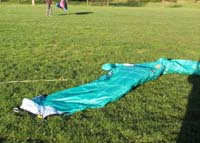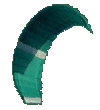As usual click on pictures to enlarge them  22-march-2002 First test was an half an hour flight in a football soccer terrain. 22-march-2002 First test was an half an hour flight in a football soccer terrain.
Wind gusting from 0 to 30-35 kn, trees and buildings around the area.
Kite rigged on a 75 cm bar and 20 m lines (4 lines).
Prefilled 2/3 from rear inflation opening. Direct downwind launch.
Impressions from this (unreliable) test:
PRO
- kite flies at first attempt : )
- very powerful (in gusts no way to keep my feet on earth)
- Huge lift component compared to drag
- good turning ability
CONS
- Had many luffs and bowtie or reverse (luff seems caused by a center leading edge collapse as soon as the kite pass over my head)
- Very small sheet range between fully depowered and stalled kite (I stalled this kite many times)
- When the kite bowties I always needed my wife to help me to start again
23-march-2002 Second fast test. Handles and 18 m lines. Wind very strong again.
Everything went wrong. Seems I cant put enough brake to stop the kite. Many uncontrolled jumps and luffs.
Distorted ankle and game over.
IMPROVEMENTS 1 (at least I hope it is)
While waiting my ankle heal i've sewed 2 adjustable webbings (similar to those that blocks spars in dacron) to trailing edge.
Now I shold be allowed to temporary "reverse wedge" my kite.This should allow me to reduce the luffing attidtude.
Also reduced the internal air intake sock from 45 cm to 25 in an attempt to gain better and faster inflation.
Waiting for new wind to make new tests. 5-april-2002 YABBBBBBBBBAAAAAIIIIIIIIIIII
Made a new test in strong and smooth wind (over 25 kn) 10 m lines and 75 cm bar for about 3 hours.
If I had my board I would be well powered up.
At start the kite is still difficult to launch and show a strong tendencies to collapse in the middle of the LE at zenith and at the edges.
I began to shorten the TE via the webbings you can see in a pic below 1 cm at time.
There are 2 webbings so a 1 cm reduction for both webbings means a real TE reduction of 4 cm.
At 16 cm TE reduction (kind of back wedging) kite performances are MUCH higher. kite is now much more stable and show no more sign of collapse. No more closing tips and a really nice fly and, open your ears, THE KITE REVERSE LAUNCH PRETTY WELL !!!
Launch from ground is still difficult as the kite need a good pull on the front lines and totally slack back lines to begin mouvement.
As soon as it moves it became very fast and all goes right.
I also tried to back wedge more than 16 cm but kite launch was more and more difficult and at 24 it completly refused to start so I think 16 cm is the best setting.
I will do some more test with 20 and 30 lines and then if my impressions will be confirmed I'll made a sewed wedge instead of the webbings to have a smooter profile
Tried with my buggy but I was way to much overpowered. I was only able to go almost straigth upwind at ligth speed with the kite at zenith. Tried a turn and found myself flying in the air.
Overall considerations:
- kite flies well and now I' m shure it will be a killer snowboarding kite : )
- It's a fuc.... jumping machine. turn the kite to top, give slack lines and prepare yoursef to be rocketed in the sky.This is a real elevator : ))
- upwind performances seems to be awsome : ))
- esear to solo launch than I expected (I used 5 water bottles to keep it on ground) : )
- kite is 80% self inflated before I unroll the lines : )
- REVERSE LAUNCH (not tried on water) : )))
- there is still a very short range between stall and full power : \
- when the kite land is pretty much difficult to relaunch (tough now i can count on reverse launch). so I'm shure it would be a difficult kite to use in water : ( ....but I'll trie and report
- kite has high performances (good) but if you let go to the top at max speed it will pass over your head and luff. No auto-back-floatation feature : ( As usual sorry for my bad english and contact me for any suggestion or question | 
